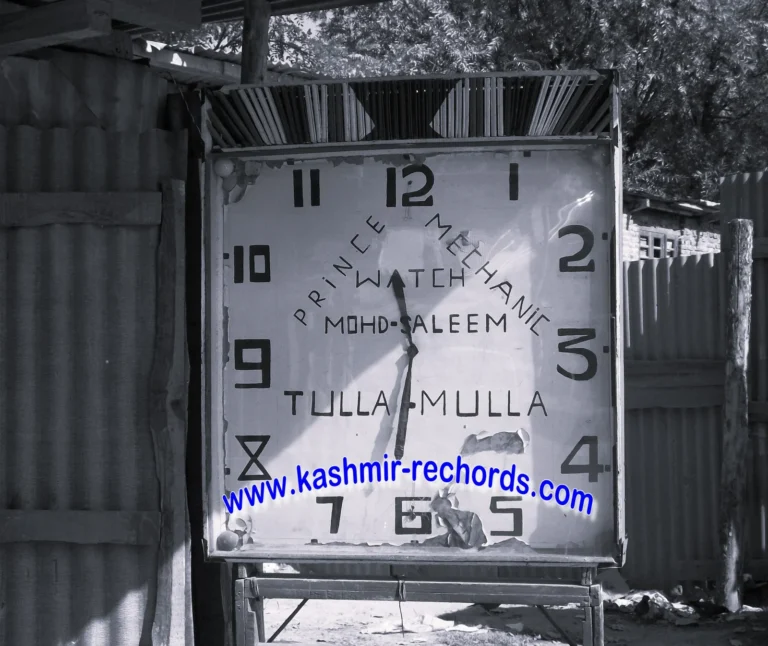
(Kashmir Rechords Exclusive)
As the Wheel of Time completes years after year since the Kashmiri Pandits began celebrating the annual Mela Kheer Bhawani in exile, the sacred Kheer Bhawani Mela every year evokes a poignant mix of nostalgia and sorrow. This day serves as a stark reminder of June 1, 1990, when the Mela was first time observed in exile. The normally vibrant Tulmulla shrine, under the majestic canopy of ancient Chinar trees, stood eerily silent that year, devoid of the overnight and morning devotees who once filled the air with hymns and prayers.
The shrine, typically alive with the bustling energy of pilgrims and the melodious chanting of hymns, was that year ( 1990) cloaked in a heavy silence. The mighty Chinar trees, which once provided shade to thousands of devotees, then stood as silent sentinels over an almost deserted temple complex. The absence was palpable, as if the valley itself was holding its breath. For the first time, there were no Yatris, no processions, no vibrant bhajans, hymns, or traditional Kashmiri Leelas. The Kashmiri Pandits, who had been the lifeblood of these celebrations for centuries, were missing en-masse, forced to flee their ancestral land amidst escalating conflict.
A Valley in Transition
As I stood there, a journalist then working for the Daily Excelsior and assisting its Kashmir Desk, the melancholy of the scene was overwhelming. The temple complex echoed with emptiness, under the watchful eyes of security forces who, new to the valley, stood as silent witnesses to a tradition they barely understood. The sacred day of Mata Kheer Bhawani seemed to slip away in the shadows of military presence and militant threats.
A first-hand account of first Mela Kheer Bhawani Mela in exile—June 1, 1990. For archival newspaper cuttings, contact Kashmir Rechords. (kashmir-rechords@gmail.com)
This was not just any day. The valley was already under strict law and order on June 1, 1990, coinciding with Mata Kheer Bhawani Mela, as a significant event was unfolding. On this very day, 15-year-old Omar Farooq was installed as the new Mirwaiz of Kashmir, following the assassination of his father, Mirwaiz Maulvi Farooq, just few days earlier.
A Lone Devotee’s Devotion
In the midst of this silence, a solitary figure caught my eye. In a remote corner of the temple, under the protective gaze of Mata Kheer Bhawani, stood a lone Kashmiri Pandit! Despite the turmoil, this devout man had chosen not to leave Kashmir. His presence was a poignant symbol of resilience and undying faith. Associated with a Government media organization, he had stayed behind to ensure that the spiritual sanctity of the shrine remained unbroken.
With quiet determination, this devout Pandit gathered information about other fellow Kashmiri Pandit employees still working under perilous conditions in the valley. In a remarkable act of solidarity, a few local Muslims, who also revered Mata Kheer Bhawani, offered their help. Through their efforts, a spokesperson of the Kashmir Motor Drivers (KMD) Association was contacted, who, despite severe tension in Srinagar, arranged two buses to transport some of those scattered Pandit employees to the shrine.
The Quiet Return of Faith
As the Sun climbed higher, casting golden rays through the leaves of the Chinar trees, two buses arrived. Slowly, a small group of Pandits disembarked, their faces a mixture of anxiety and reverence. Despite the heavy guard and underlying tension, they had come to ensure that the Kheer Bhawani Mela did not pass without its customary puja and worship.
The puja was performed that day, not with the usual grandeur but with a profound sense of purpose. The devotees, though few, followed all traditions and customs, their prayers mingling with the rustling leaves and the soft murmur of the spring where the deity is seated. It was a solemn ceremony, deeply moving, a quiet assertion that faith could not be silenced by fear.
This was perhaps the first puja at the shrine since the beginning of 1990. For months, the temple had been under the watchful eyes of security personnel, except for that one devoted Pandit who had pledged not to leave the shrine complex until his death. His unwavering presence was a beacon of hope and continuity amidst the chaos.
Years of Sparse Devotion
In the years that followed, the presence of devotees at Kheer Bhawani remained sparse, limited mainly to employees of the Civil Secretariat, AG Office, and other Central government workers stationed in Kashmir. The shrine, once a bustling centre of spiritual activity, became a guarded sanctuary, out of reach for the majority of its community. Kashmiri Pandits, scattered and displaced, recreated their sacred spaces in Jammu, Delhi, and other parts of India, keeping the spirit of the shrine alive in their hearts and homes.
By 1997, the shrine began to see a resurgence. With the easing of tensions, Kashmiri Pandits started visiting the shrine again, either through government-sponsored transport or private arrangements made by their community. The shrine saw visits from politicians of all hues and even militant leaders, each seeking to extend their sympathies or make their presence known on the days of the Mela. Despite the political undercurrents, these gatherings also became a rare opportunity for old friends from both communities to reconnect, to remember and cherish their shared past.
A Testament to Resilience
The story of June 1, 1990, at the Kheer Bhawani shrine is a testament to the indomitable spirit of the Kashmiri Pandits and the profound respect for faith that transcends communal boundaries. It is a story of loss and resilience, of the sacred and the profane intertwining in the valley of Kashmir. As we look back, it is a poignant reminder that even in the darkest of times, the flame of devotion burns brightly, undeterred by the shadows that seek to engulf it.
* (The write-up is a first-hand account of Rajesh Bhat, Ph.D. in Mass Communication and Journalism with over 35 years of experience as a Journalist, writer, researcher, and academician in journalism, spanning both print and electronic media. He authored “Radio Kashmir in Times of Peace and War” and has worked with prestigious newspapers and publications including Kashmir Times, Daily Excelsior and The Tribune, Chandigarh. Currently, he serves as a Faculty Member at the National Academy of Broadcasting and Multimedia, New Delhi.)i
